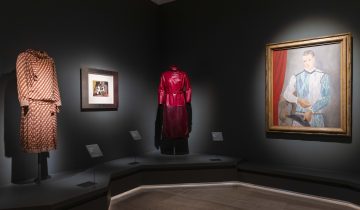Hilma af Klint (1862–1944) is widely regarded as one of Sweden’s most esteemed artists and is celebrated worldwide.
Born in Stockholm, af Klint studied at the city’s Royal Academy of Fine Arts, graduating with honors in 1887. She quickly established herself as a respected artist in Stockholm, exhibiting figurative paintings and briefly serving as the secretary of the Association of Swedish Women Artists. From a young age, she delved into spiritualism, later expanding her interests to include the ideas of Rosicrucianism, Theosophy, and Anthroposophy. These spiritual pursuits were part of the zeitgeist and gained popularity across Europe, particularly in artistic and literary circles, as individuals sought to reconcile religious beliefs with scientific advances and a growing awareness of the diversity of religions.

Hilma af Klint
Grupo VI, Evolución, n.º 16, Serie WUS/Estrella de siete puntas
(Grupp VI, Evolutionen, nr 16, Serie WUS/Sjustjärnan), 1908
Óleo sobre lienzo
102 x 133 cm
The Hilma af Klint Foundation, Estocolmo HaK 84
Af Klint’s conventional paintings served as her primary source of financial income. However, what she often referred to as her “great work,” realized during her lifetime, remained a separate and more spiritually oriented activity. Only those with a deep interest in spiritual matters were aware of this body of work. Despite her attempts to exhibit these paintings to like-minded individuals, they were largely unsuccessful. Remarks in her notebooks suggest that she believed the world was not quite ready for the message these works aimed to communicate.
Intriguingly, at the Academy of Fine Arts, Hilma af Klint formed a significant friendship with Anna Cassel, one of the four women with whom she co-founded “The Five.” This group, active between 1896 and 1908, embarked on explorations of spiritual realms through meditation and séances. The other members of The Five were Cornelia Cederberg, Sigrid Hedman, and Mathilda Nilsson. Intriguingly, all these women had prior membership in the Edelweiss Society, an association in Stockholm that melded Christian ideas, theosophical teachings, and spiritualism.
During their activities, The Five, including af Klint, engaged in recording messages from higher spirits referred to as The High Masters. In trancelike states, they believed they could communicate with mystic beings such as Amaliel, Ananda, and Gregor—seen as intermediaries of The High Masters. This communication took the form of automatic writing and drawing, with the group transcribing messages received during these sessions.

In 1907, Hilma af Klint asserted that she had received a message indicating her role as the leader of the group. However, the other four members rejected this new order, leading to the disintegration of the group, which subsequently ceased its collective work. Following this development, af Klint dedicated herself entirely to what she referred to as the “great commission” known as “The Paintings for the Temple,” which became her most significant body of work. This marked a pivotal moment in her artistic journey as she shifted her focus towards the creation of these spiritually inspired and groundbreaking paintings.
Around the turn of the twentieth century, Stockholm welcomed prominent figures from various spiritual movements. Hilma af Klint actively participated in this milieu, attending lectures by theosophists Annie Besant and Rudolf Steiner. Her personal library included key theosophical writings by Madame Blavatsky and an extensive collection of works by Steiner. Later, she became an active member of the Anthroposophical Society, founded in 1913. In the 1920s, af Klint spent extended periods in Dornach, Switzerland, where Rudolf Steiner had established the movement’s center, the Goetheanum.
During her lifetime, af Klint’s conventional paintings found their way into numerous exhibitions. However, her non-figurative works were primarily showcased within anthroposophical and theosophical circles. It wasn’t until decades after her passing that her art gained serious attention. In 1986, the Los Angeles County Museum of Art (LACMA) featured her works in the survey exhibition titled “The Spiritual in Art: Abstract Painting 1890-1985.” Subsequently, interest in her esoteric paintings has steadily grown, and today, her work is regularly displayed in significant museums worldwide.
A pivotal moment came in the autumn of 2018 with the exhibition “Hilma af Klint: Paintings for the Future” at the Guggenheim Museum in New York. This exhibition became the best-attended in the history of the institution, underlining the increasing recognition and appreciation for Hilma af Klint’s visionary and groundbreaking contributions to the world of art.
Additionally, it is noteworthy that a new exhibition featuring Hilma af Klint’s work is scheduled to open at the Guggenheim Museum in Bilbao in October 2024, providing another occasion for art enthusiasts to explore and appreciate her influential contributions to the world of abstract art.




 No products in the cart.
No products in the cart.